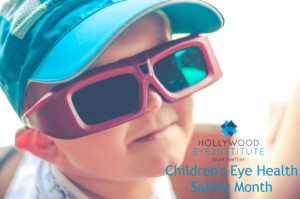Children’s Eye Healthcare and Safety
Summer is slowly coming to an end as we welcome August and back to school fever is stronger than ever. While we prep our children with school supplies for another productive school year, it’s important to recognize that it’s Children’s Eye Health and Safety Month. Parents nationwide are buying the sharpest #2 pencils, reviewing class schedules, and readjusting bed times. However, the back to school checklist is not complete without proper eye care. To honor Children’s Eye Health and Safety Month, we’re presenting our official Children’s Eye Safety Guide.
- Preventative Measures – More than 12 million children are afflicted by a form of vision impairment. Eye injuries are one of the leading causes of vision loss in children. Often times, these eye injuries are a result of sport related injuries. In order to mitigate risk, we recommend wearing eye protectors made with polycarbonate lenses for sports such as basketball, football, soccer, etc. We recommend practicing safe use if common items injuries like paper clips, pencils, rubber bands, and hangers. When purchasing toys for children, purchase toys marked with “ATSM”, which means the product meets the national safety standards set by the American Society for Testing and Materials.
- Examinations – Most children have healthy eyes and do not suffer from any vision impairment. However, there are conditions that that lie dormant in the eye for long periods of time . These conditions cannot be seen by simply looking into an individual’s eyes. As a result, we recommend scheduling regular eye exams. Regular eye exams are the best way to ensure a child maintains great vision throughout their life. Did you know that HEI tests test for common eye conditions such as Astigmatism, Presbyopia, Myopia and Hyperopia? For a comprehensive range of eye conditions we test for, visit our ocular conditions page.
- Warning Signs – While the most effective way to test for an eye condition is an eye examination, there are warning signs to look for in children. Below are a few examples that might indicate that a child has may have vision problems.
- Wandering or crossed eyes
- A family history of childhood vision problems
- Disinterest in reading or viewing distant objects
- Squinting or turning the head in an unusual manner while watching television
These warning signs could be forms of eye diseases such as Amblyopia, Strabismus, Ptosis, Color deficiency, and etc.
- First Aid – Even with the proper preventative measures taken, accidents still happen. In the event of an eye emergency, locate an ophthalmologist, primary care doctor, school nurse, or children’s health service. Delaying medical attention can result in a minor injury escalating to a major injury. While seeking medical attention, avoid touching or rubbing the affected area if the eye. If there is an object stuck, do not attempt to remove it. A cut should just be gently covered.
At HEI, eye safety is a top priority, especially in children. Want to ensure your eyes stay healthy?
Call us today and schedule a free eye examination with one of our skilled doctors. Eye safety is the theme of August, but we recommend practicing eye safety all year round.
On social media? Like us on Facebook & Follow us on Twitter
Sources: Health Alliance Plan of Michigan, American Academy of Ophthalmology, Prevent Blindness

